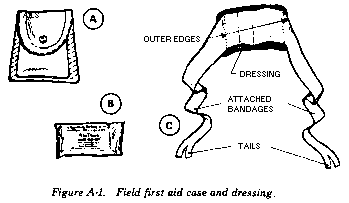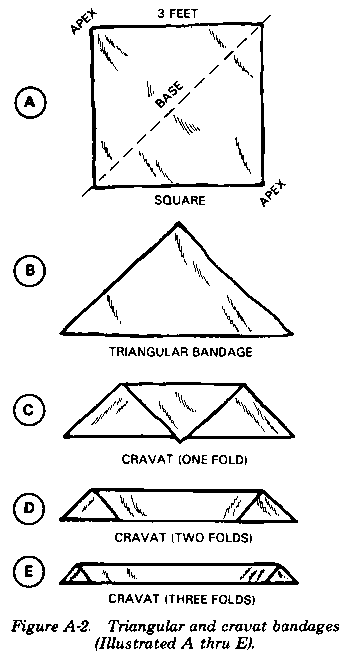First Aid for Soldiers FM 21-11
FM 21-11 First Aid for Soldiers: Appendix A
First Aid Case and Kits, Dressings, and Bandages
Headquarters, Department of the Army, Washington, D.C., October 27, 1988
A-1. First Aid Case with Field Dressings and Bandages
Every soldier is issued a first aid case (Figure A-1A) with a
field first aid dressing encased in a plastic wrapper (Figure A-1B).
He carries it at all times for his use. The field first aid dressing is a standard sterile
(germ-free) compress or pad with bandages attached (Figure A-1C).
This dressing is used to cover the wound, to protect against further contamination, and to
stop bleeding (pressure dressing). When a soldier administers first aid to another
person, he must remember to use the wounded person's dressing; he may need his own later.
The soldier must check his first aid case regularly and replace any used or missing
dressing. The field first aid dressing may normally be obtained through the medical unit's
assigned medical platoon or section.

A-2. General Purpose First Aid Kits
General purpose first aid kits listed in paragraph A-3
are also listed in CTA 8-100. These kits are carried on Army vehicles, aircraft, and boats
for use by the operators, crew, and passengers. Individuals designated by unit standing
operating procedures (SOP) to be responsible for the kits are required to check them
regularly and replace all items used, or replace the entire kit when necessary. The
general purpose kit and its contents can be obtained through the unit supply system.
NOTE
Periodically check the dressings (for holes or tears in the package) and the medicines
(for expiration date) that are in the first aid kits. If necessary, replace defective or
outdated items.
A-3. Contents of First Aid Case and Kits
The following items are listed in the Common Table of Allowances (CTA) as indicated
below. However, it is necessary to see referenced CTA for stock numbers.
Unit of
CTA Nomenclature Issue Quantity
a. 50-900 ...CASE FIELD FIRST AID DRESSING............ each.......... 1
Contents: 8-100.....
-
Dressing, first aid field, individual troop, white, 4 by 7 inches..............
each.......... 1
b. 8-100 ....FIRST AID KIT, general purpose........... each.......... 1 (Rigid
Case) Contents:
-
Case, medical instrument and supply set, plastic, rigid, size A, 7 1/2 inches long by 4
1/2 inches wide by 2 3/4 inches high............... each.......... 1
-
Ammonia inhalation solution, aromatic, ampules, 1/3 ml, 10s....................
package....... 1
-
Povidone-iodine solution, USP: 10% 1/2 fl oz, 50s..........................
box........... 1/50
-
Dressing, first aid, field, individual troop, camouflaged, 4 by 7 inches.......
each.......... 3
-
Compress and bandage, camouflaged, 2 by 2 inches, 4s.......................
package....... 1
-
Bandage, gauze, compressed, camouflaged, 3 inches by 6 yards........ each.......... 2
-
Bandage, muslin, compressed, camouflaged, 37 by 37 by 52 inches...... each.......... 1
-
Gauze, petrolatum, 3 by 36 inches, 3s.... package....... 1
-
Adhesive tape, surgical 1 inch by 1 1/2 yards, 100s............. package....... 3/100
-
Bandage, adhesive, 3/4 by 3 inches 300s....................................
box........... 18/300
-
Blade, surgical preparation razor, straight, single edge, 5s...............
package....... 1
-
First aid kit, eye dressing.............. each.......... 1
-
Instruction card, artificial respiration, mouth-to-mouth resuscitation (Graphic Training
Aid 21-45) (in English)................. each.......... 1
-
Instruction sheet, first aid (in
English)............................ each.......... 1
-
Instruction sheet and list of contents (in English)................... each.......... 1
c. 8-100.....FIRST AID KIT, general purpose........... each.......... 1
(panel-mounted) Contents:
-
Case, medical instrument and supply set, nylon, nonrigid, No. 2, 7 1/2 inches long by 4
3/8 inches wide by 4 1/2 inches high............... each.......... 1
-
In Upper Ammonia Inhalation Solution Pocket.... aromatic, ampules, 1/3 ml, 10s..........
package....... 1
-
Compress and bandage, camouflaged, 2 by 2 inches, 4s.......................
package....... 1
-
Bandage, muslin, compressed, camouflaged, 37 by 37 by 52 inches...... each.......... 1
-
Gauze, petrolatum, 3 by 36 inches, 12s... package....... 3/12
-
Blade, surgical preparation razor, straight, single edge, 5s............... package
...... 1
-
In Lower Pad, Povidone-Iodine, 100s............... box........... 10/100 Pocket...
-
Dressing, first aid, field, individual troop, camouflaged, 4 by 6 inches.......
each.......... 3
-
Bandage, gauze, compressed, camouflaged, 3 inches by 6 yards........ each.......... 2
-
Adhesive tape surgical, 1 inch by 1 1/2 yards, 100s............. package....... 3/100
-
Bandage, adhesive, 3/4 by 3 inches, 300s....................................
box........... 18/300
-
First aid kit, eye dressing.............. each.......... 1
-
Instruction card, artificial respiration, mouth-to-mouth resuscitation (Graphic Training
Aid 21-45) (in English)................. each.......... 1
-
Instruction sheet, first aid (in English)............................ each.......... 1
-
Instruction sheet and list of contents (in English)................... each.......... 1
A-4. Dressings
Dressings are sterile pads or compresses used to cover wounds. They
usually are made of gauze or cotton wrapped in gauze (Figure A-1C).
In addition to the standard field first aid dressing, other dressings such as sterile
gauze compresses and small sterile compresses on adhesive strips may be available under
CTA 8-100. See paragraph A-3 above.
A-5. Standard Bandages
a. Standard bandages are made of gauze or muslin and are used over a sterile
dressing to secure the dressing in place, to close off its edge from dirt and germs, and
to create pressure on the wound and control bleeding. A bandage can also support an
injured part or secure a splint.
b. Tailed bandages may be attached to the dressing as indicated on the field
first aid dressing (Figure A-1C).
A-6. Triangular and Cravat (Swathe) Bandages
a. Triangular and cravat (or swathe) bandages (Figure A-2)
are fashioned from a triangular piece of muslin (37 by 37 by 52 inches) provided in the
general purpose first aid kit. If it is folded into a strip, it is called a cravat. Two
safety pins are packaged with each bandage. These bandages are valuable in an emergency
since they are easily applied.
b. To improvise a triangular bandage, cut a square of available material,
slightly larger than 3 feet by 3 feet, and FOLD it DIAGONALLY.
If two bandages are needed, cut the material along the DIAGONAL FOLD.
c. A cravat can be improvised from such common items as T-shirts, other
shirts, bed linens, trouser legs, scarfs, or any other item made of pliable and durable
material that can be folded, torn, or cut to the desired size.

|




